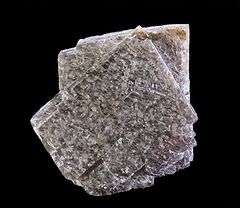Sanidine
| Sanidine | |
|---|---|
|
Sanidine - Puy de Sancy, Monts-Dore massif, Puy-de-Dôme, Auvergne, France. (5x4.5cm) | |
| General | |
| Category | Feldspar |
| Formula (repeating unit) | K(AlSi3O8) |
| Strunz classification | 9.FA.30 |
| Dana classification | 76.01.01.02 |
| Crystal system | Monoclinic |
| Crystal class |
Prismatic (2/m) H-M symbol: (2/m) |
| Space group | C2/m |
| Identification | |
| Color | Colorless to white |
| Crystal habit | Tabular crystals, may be acicular |
| Twinning | Carlsbad twinning common |
| Cleavage | {001} perfect, {010} good |
| Fracture | Uneven |
| Tenacity | Brittle |
| Mohs scale hardness | 6 |
| Luster | Vitreous, pearly on cleavage |
| Streak | White |
| Diaphaneity | Transparent to translucent |
| Specific gravity | 2.52 |
| Optical properties | Biaxial (-) |
| Refractive index | nα = 1.518 - 1.525 nβ = 1.523 - 1.530 nγ = 1.525 - 1.531 |
| Birefringence | δ = 0.007 |
| 2V angle | Measured: 18° - 42° (low); 15° - 63° (high) |
| References | [1][2][3] |
Sanidine is the high temperature form of potassium feldspar with a general formula K(AlSi3O8).[1] Sanidine is found most typically in felsic volcanic rocks such as obsidian, rhyolite and trachyte. Sanidine crystallizes in the monoclinic crystal system. Orthoclase is a monoclinic polymorph stable at lower temperatures. At yet lower temperatures, microcline, a triclinic polymorph of potassium feldspar, is stable.
Due to the high temperature and rapid quenching, sanidine can contain more sodium in its structure than the two polymorphs that equilibrated at lower temperatures. Sanidine and high albite constitute a solid solution series with intermediate compositions termed anorthoclase. Exsolution of an albite phase does occur; resulting cryptoperthite can best be observed in electron microprobe images.
References
- Hurlbut, Cornelius S.; Klein, Cornelis, 1985, Manual of Mineralogy, 20th ed., Wiley, ISBN 0-471-80580-7
